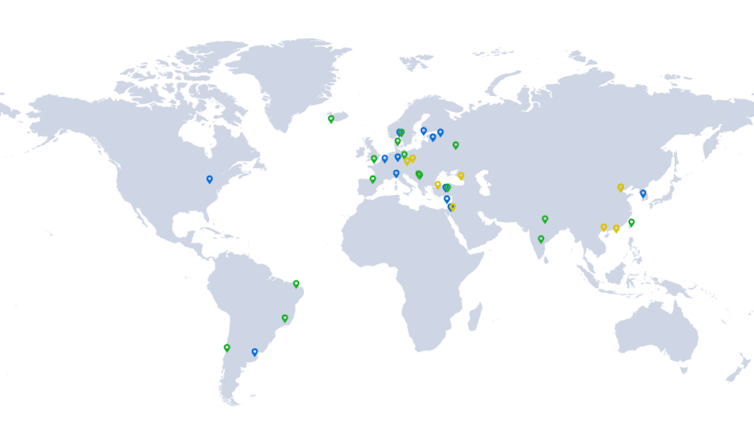Source: The Conversation – Canada – By Alison Taylor, Professor, Department of Educational Studies, University of British Columbia
The skills “every student needs” for the 21st century include competencies in technology, problem solving and communication — and character qualities like adaptability and grit.
This is according to the World Economic Forum, but by now, we should be familiar with this kind of rhetoric. Think tanks, employers and policymakers amplify similar ideas around what graduates need to get good jobs and contribute to economic growth.
Such discourse and policy put pressure on universities to be more responsive to a labour market that is more precarious than the one faced by previous generations.
In turn, university students feel pressure to make the best decisions. It’s small wonder that more students are adjusting their study and career plans in efforts to secure their futures.
My recent book, Juggling Rhythms, frames university students’ diverse tactics (and survival skills) as “circus arts.” This way of examining student experiences is deeply informed by what I heard in interviews with students, and reveals aspects of their experiences that would not otherwise be apparent.
Working while studying full-time
I gained insight into these questions during a research study that I led between 2018 and 2023, which focused on undergraduate students who work while studying full-time at two research-intensive universities in Canada.
We approached this research aware of the plethora of advice for students to make themselves employable. We wondered: What do students themselves think? How are they feeling about their future careers — excited and eager, anxious and pessimistic or somewhere in between?
More than half of undergraduates engage in term-time work while studying and many pursue other forms of work-integrated learning as well.
Undergraduates are recognizing the importance of 21st century “circus arts” as they labour to learn in today’s economy, characterized by extreme wealth inequality, globalization and the dominance of multinational corporations.
Circus arts metaphors
The “circus arts” metaphors were sparked by qualitative research with 57 students at one university between 2020 and 2022. Our methods included focus group interviews, life maps, audio diaries and one-on-one follow-up interviews.
Of these 57 students, 39 identified as female, 40 were racialized, 16 were international and 17 were first-generation Canadian. They were enrolled in a range of programs across campus, many in the largest faculties of arts and science.
In my book, I consider how students are concerned with:
• How to manipulate different “objects” (juggling)
• How to adjust and recalibrate their activities and expectations (high-wire walking)
• How to learn their limits and bend in ways that don’t compromise care for self and others (contortion); and
• How to expend energy instrumentally and avoid burnout (sword swallowing).
Varying degrees of freedom and ease
Different students take up these “circus arts” in varied ways and degrees of freedom and ease. For instance, many students juggle more than paid work and studies.
Women are more likely to juggle volunteer work required for admission into feminized professional programs as well as care work in families. International students add the labour of acclimatizating to a new country with employment to offset disproportionately high tuition.
I observe that the art of high-wire walking tends to be less challenging for students who enter university with varied experiences and who have strong safety nets provided by families.
In contrast, financially insecure students, especially those who are racialized or live with disabilities, navigate more cautiously as they try to anticipate obstacles.
For example, one interviewee, Lucy, relayed how her disability required her to adjust studies and work when she was close to the point of burning out. First-generation student, Michael, had little room for error as he lived “paycheque to paycheque” on earnings from his retail job while pursuing full-time studies.
Costs of contortion and competition
Dominant discourses frame youth as autonomous, independent decision-makers who exhibit Gumby-like capacities to stretch and compress themselves into education and employment systems.
However, I observe that the “art of contortion” also involves discovering the costs of hyper-flexibility and limits on the ability to stretch in different directions.
For example, Kay came “pretty close to dropping out” because of mental health issues that were exacerbated by the competitive climate on campus. Fortunately, support from her parents and a sympathetic employer on campus helped her persevere.
Similarly, Janice, a racialized international student, compared her cohort to a “herd of lions trying to kill each other.” Her perception of steep competition for work placements coupled with her challenges to “fit in” to Canadian systems led to her realization that “there’s only so much we can take” and “you don’t have to take the path that every other person takes.”
Read more:
International students’ stories are vital in shaping Canada’s future
Sword swallowing
Students learn their limits as they bump up against the rigidity of demanding education and employment systems and as they navigate family expectations.
Pressure to take on too much can be irresistible in a context where a bachelor’s credential is no longer seen as sufficient and the smorgasbord of extra-credential activities is dizzying.
The dangers of sword swallowing — which involves suppressing one’s natural defence mechanisms — are reflected in students’ comments about burnout, exhaustion and poor mental health.
For example, Helena’s disability meant that she was always playing “catch up” despite the long hours she put into her studies. When combined with a retail employer who wasn’t accommodating, she reflected, “my mental health isn’t that great” and “my personal battery is dead.”
Erosion of familiar pathways
Participants in the study perceived an imperative to be planful, employable and productive (what I call “PEP talk”) because of the erosion of familiar institutional pathways and institutional safety nets coupled with the uncertain value of university credentials.
What could universities do to reduce the time pressure on students who experience the most precarity? There are calls to tie universities even more closely to job markets: mandating work-integrated learning, adding micro-credentials and packing more into programs.
I’m not convinced these approaches will do the trick. Instead, I think we need to move away from universities trying to meet the demands of constantly shifting global labour markets by producing graduates who can “hit the ground running.”
Paradigm shift needed
A paradigm shift is needed for three main reasons. First, the timescale of universities is (and should be) longer than the economic quarter. Innovation and responsiveness to communities does not mean reacting to every report on business.
Second, everything is not up to universities. Employers must take more responsibility for creating rewarding and sustainable entry-level positions with training. This does not mean adding more unpaid internships.
Finally, more institutional supports are needed to create the space and time for students to decide who they aspire to be, explore possible directions for work and career and discover what they value (including things beyond economic returns on educational investments.
This could mean lower tuition, more financial support for financially insecure students and the equitable distribution of work opportunities on campus.
It also means instructors and researchers modelling the kind of patient and careful scholarship that will help us see our way forward in a complex and crisis-prone world.
![]()
Alison Taylor received funding from the Social Sciences and Humanities Research Council of Canada.
– ref. To survive today’s economy, university students are using circus-like tactics – https://theconversation.com/to-survive-todays-economy-university-students-are-using-circus-like-tactics-264839





